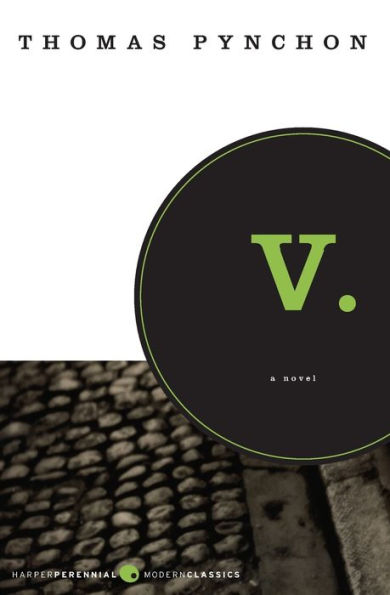Reading Group Guide
Plot Summary
It's Christmas Eve, 1955, and ex-seaman Benny Profane--"a schlemihl and human yo-yo"--is back in Norfolk, Virginia, with some old Navy buddies and Paola Maijstral, the enigmatic barmaid from Valletta, Malta. By January, he and Paola are in New York City with a group of wastrels self-styled The Whole Sick Crew; and Profane roams the streets and the sewers (hunting alligators) of a city that seems to just bounce him back in forth. In the meantime, Herbert Stencil--questing son of a dead British Foreign Office man--has been, since 1945, hunting for the utterly mysterious V., an unknown (perhaps unknowable) woman whom Stencil knows only from an entry in his late father's journals--"Florence, April, 1899 . . . There is more behind and inside V. than any of us had suspected. Not who, but what: what is she." And he knows, he has intuited, "that she'd been connected . . . with one of those grand conspiracies or foretastes of Armageddon which seemed to have captivated all diplomatic sensibilities in the years preceding the Great War. V. and a conspiracy." By January 1956, Stencil's search has brought him to New York City, where his and Benny Profane's paths inevitably cross. From that point of crossing, Thomas Pynchon's first novel takes readers on a wild and wonderful tour of the twentieth century and of contemporary America. Record-company and armaments executives (Roony Winsome and Clayton "Bloody" Chiclitz) jostle on these pages with British spies and Nazi rocket builders (Eric Bongo-Shaftsbury and Kurt Mondaugen), dentists and plastic surgeons (Dudley Eigenvalue and Shale Shoenmaker) rub metaphoric elbows with street gangs andjazz musicians (the Playboys and McClintic Sphere). And all the while, the world has either run down into meaninglessness or is run by a vast conspiracy that imposes a single absolute meaning on everyone.
Discussion Topics
1. To what extent can V. be read as "an analysis" of the decadence of the 1950s and, by extension, of the decadence of all of twentieth-century western culture?
2. In what ways is Benny Profane a "schlemihl" and a passive victim of circumstances? What are the causes and consequences of his repeated, frequently self-professed victimization? As a "human yo-yo," how is he the plaything of his culture and of history?
3. What are the nature and purpose of Herbert Stencil's quest? What does Pynchon mean when he writes that "Stencil was in time to be the century's child"? How does Stencil's search for V. reveal the decadence of European colonialism and of twentieth-century western culture?
4. Who are the various women who bear the initial "V"? What do these women represent? In addition to these women, what other persons, objects, places, and concepts are associated with the letter? How does the letter "V," as the novel's title and central symbol, effectively focus all of the primary motifs in the novel?
5. How does Pynchon illustrate the concept of entropy--the deterioration of all systems to a state of absolute inertness in which all creative energies have been dispersed? What characters and situations are most pointedly associated with entropy? What "rescues" from decay and deterioration do various characters put forward, and with what results?
6. What are the layouts and goals of the novel's various labyrinths or mazes, of either space or time? What do Profane, Stencil, and other characters discover about themselves and about history as they navigate their labyrinths?
7. What do Chiclitz, Schoenmaker, Winsome, and Eigenvalue represent? How are they related to the British Foreign Office men, Nazi officers, and other professionals who figure in Stencil's quest?
8. In what ways--and to what degree--do Profane, Stencil, and others attempt to create order out of disorder? Is any one character's approach in this regard more successful than those of the others?
9. Herbert Stencil's father says, "Suppose, sometime between 1859 and 1919, the world contracted a disease which no one ever took the trouble to diagnose because the symptoms were too subtle--blending in with the events of history, no different one by one but altogether--fatal." How would you describe that disease? How may V. be read as Pynchon's diagnosis of it?
10. Rachel thinks of the people in Dr. Schoenmaker's waiting room as only one group of "a transient population of the imperfect, the dissatisfied." In what ways do you think Rachel's perception describes all the characters in the novel?
About the Author
Born in 1937, Thomas Pynchon is the author of
V., The Crying of Lot 49, Gravity's Rainbow, Vineland, and
Mason & Dixon.


